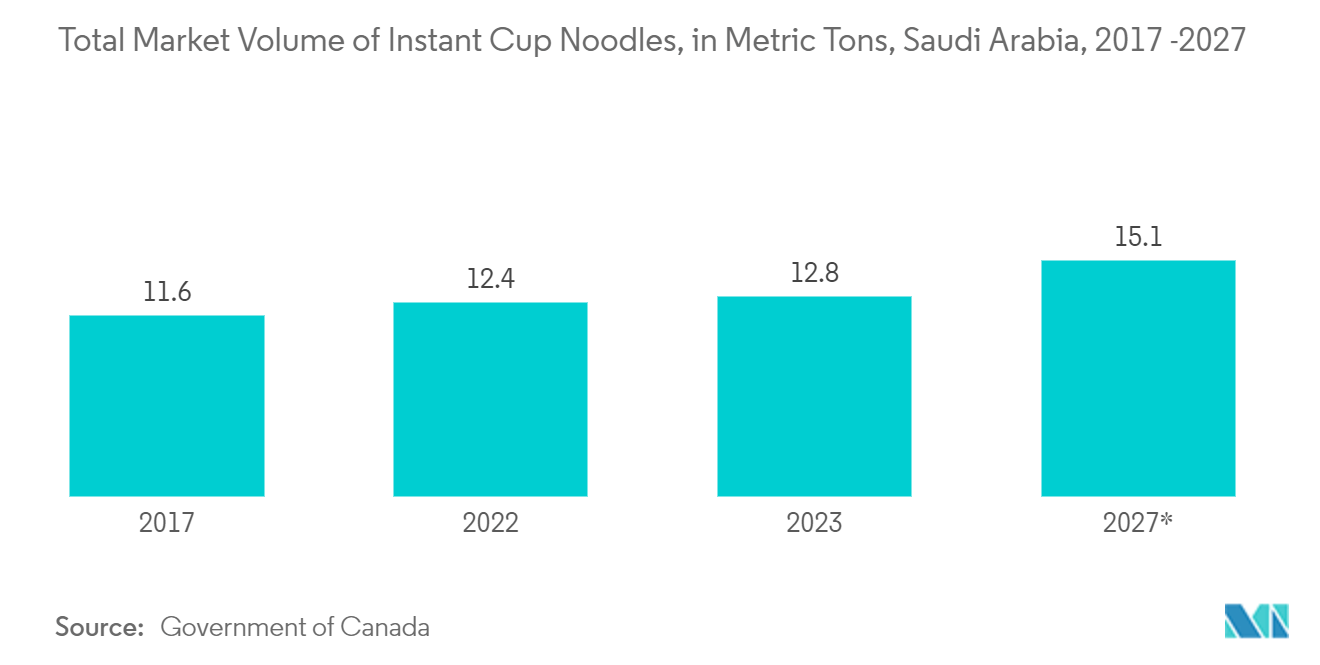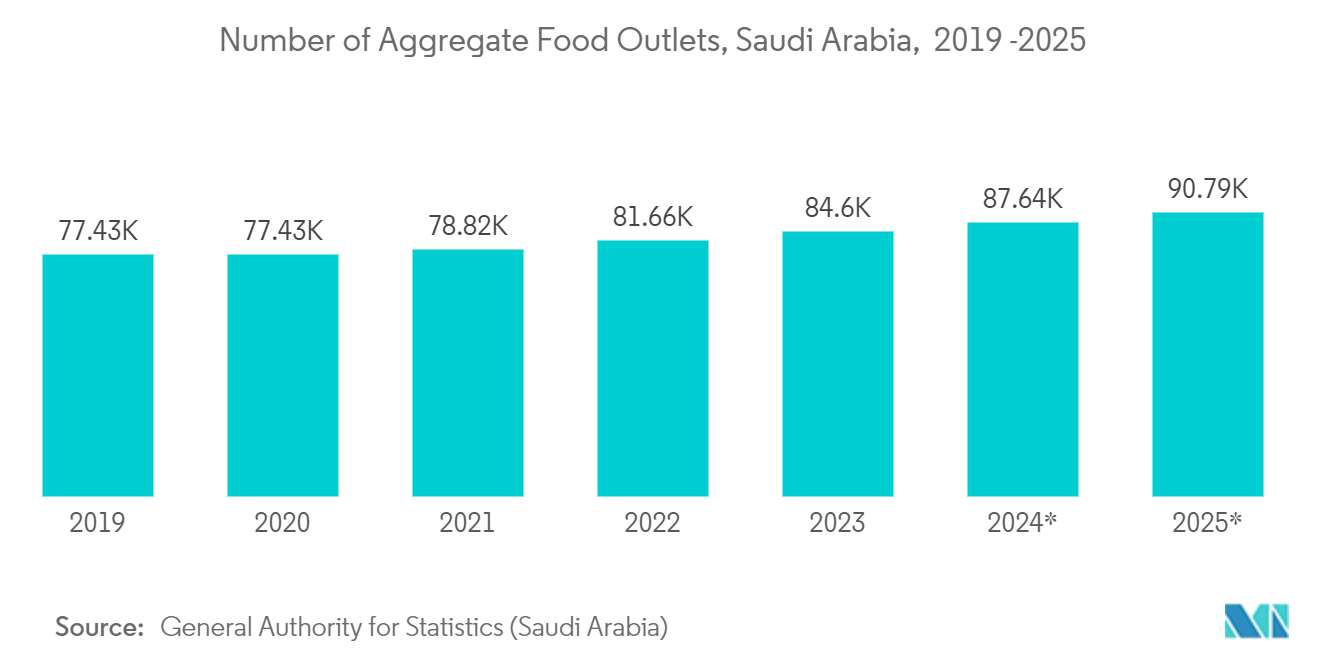Market Trends of Saudi Arabia Foodservice Disposable Packaging Industry
Cups and Lids to Hold Major Market Share
- The rise in tea, coffee, and soft drinks consumption on account of a considerable increase in the population is one of the key factors catalyzing the demand for cups and lids in the region. The burgeoning food and beverage industry and the escalating order for disposable packaging in quick service restaurants (QSRs) to minimize the risk of leakage and spillage of different food products and beverages positively influence the market studied. The emerging trend of social gatherings on special occasions and events also drives the country's need for disposable cups and lids.
- The demand for disposable cups for hot and cold beverages is rising, primarily fueled by quick-service restaurants. Moreover, the growing trend of using these cups for water consumption at various commercial and residential gatherings further propels the market. Additionally, the convenience and cost-effectiveness of disposable cups make them a popular choice in these settings, contributing to their increased adoption.
- Starbucks marked a milestone in July 2023 by inaugurating its 400th store in Saudi Arabia, featuring a Reserve outlet in Jeddah Park. This new addition in Jeddah complements the existing trio of Reserve stores in Riyadh, the nation's capital. These upscale locations showcase Starbucks' super-premium coffee offerings, aligning with Saudi Arabia's burgeoning coffee scene. Notably, international boutique brands like EL&N, Arabica, and Café Kitsuné have also made recent inroads into the Saudi market. Strategic investments and expansions are poised to fuel the market’s growth throughout the forecast period.
- Originating from Asia, instant noodles have secured a notable position in Saudi Arabia's food market. Known for their convenience, extended shelf life, and versatility in flavors, they resonate well with the nation's fast-paced lifestyle. Available in cup and bowl formats, these noodles are now emblematic of swift dining choices, trendy among the younger populace.
- Additionally, the growing trend of international cuisines and the increasing number of working professionals have fueled the demand for instant noodles in the region. For instance, in Saudi Arabia, the total market volume of instant cup noodles increased significantly from 11.60 million metric tons in 2017 to 12.80 million metric tons. It is forecasted to reach 15.10 million metric tons by 2027. This upward trend shows the future opportunity for disposable noodle cup vendors to increase their presence due to high demand.
- Organizations are increasingly advocating for paper cups over plastic, driven by the environmental harm associated with plastic cups. This shift has significantly influenced the disposable packaging market. Additionally, heightened awareness of cleanliness and hygiene has led consumers to view disposable paper cups as safer than their reusable counterparts. This preference stems from the fact that paper cups undergo high-heat manufacturing, effectively sterilizing the product by eliminating bacteria.

HoReCa Expected to Hold Significant Share in the Market
- The HoReCa segment, which comprises hotels, restaurants, and cafes, is experiencing a significant demand for food service disposables. Several major factors drive this demand, including the growing number of food outlets and restaurants and millennials' increasing preference for junk food and processed foods. Additionally, the rise in consumer spending on food delivery and the need to ensure timely delivery of orders have also significantly boosted this demand.
- The country's quick-service restaurant sector is poised to maintain its reliance on disposable packaging. Over the forecast period, the sector's push to shrink its carbon footprint and embrace eco-friendly practices is expected to propel the demand for sustainable materials, mainly paper-based packaging. This trend will likely influence the entire supply chain, from manufacturers to end consumers, as businesses increasingly prioritize sustainability.
- The Saudi tourism sector is witnessing a notable shift as both public and private entities collaborate to broaden tourist demographics and redefine the tourism narrative, moving beyond its historical focus on business and religious travel. Projections from the World Travel and Tourism Council suggest that Saudi Arabia's travel and tourism industry is poised for an impressive 11% annual growth over the coming decade, positioning it as the Middle East's most rapidly expanding market. This growth trajectory is expected to reshape the region's food and beverage landscape and align with Saudi Arabia's broader modernization and economic diversification strategies.
- Saudi Arabia's food industry is poised for a significant transformation, capitalizing on the ambitious giga-projects and a wave of upscale hotel launches. Notably, renowned fine dining establishments have extended their reach, setting up temporary outlets during the Jeddah and Riyadh Seasons. Furthermore, the hospitality sector's (HORECA) expanding investments signal a promising future for the market. The country’s strategic initiatives aim to diversify its economy, with the food industry playing a pivotal role in this vision. These developments are expected to attract local and international investors, fostering a competitive and dynamic market environment.
- Furthermore, the Saudi food service sector relies heavily on local offerings and prominent global brands. Notably, the fast-food segment, led by giants like McDonald's, Subway, and KFC, underscores this trend. Consequently, there is a heightened demand for disposable packaging. This demand is driven by the convenience and efficiency that disposable packaging offers, catering to consumers' fast-paced lifestyles. Additionally, the growth of online food delivery services has further amplified the need for reliable and sustainable packaging solutions.
- The rise in food outlets underscores the expansion of the food and beverage industry, underscoring the urgency for food service packaging solutions that align with consumer preferences and regulatory mandates. For instance, the number of aggregate food outlets in Saudi Arabia shows trending growth from 77,431 in 2017 to 84,596 in 2023 and is forecasted to reach 90,791 by 2025. The number of food outlets in the country is increasing due to the high demand in consumption, which directly impacts the number of different disposable food packaging.


